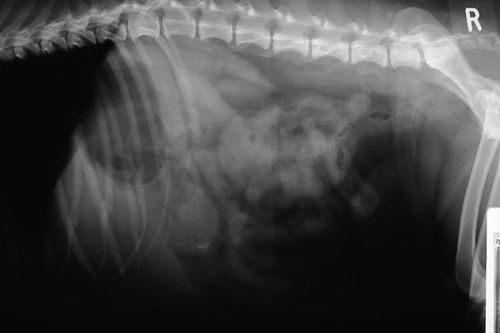Difference between revisions of "Small Animal Abdominal and Metabolic Disorders Q&A 19"
(Created page with "[[|centre|500px]] <br /> '''This lateral abdominal radiograph is of a four year-old, unilateral cryptorchid male dog exhibiting bilaterally symmetrical non-pruritic alopecia, g...") |
|||
| (2 intermediate revisions by 2 users not shown) | |||
| Line 1: | Line 1: | ||
| − | [[|centre|500px]] | + | {{Manson |
| + | |book = Small Animal Abdominal and Metabolic Disorders Q&A}} | ||
| + | |||
| + | [[File:SmAn Ab and Met 19.jpg|centre|500px]] | ||
<br /> | <br /> | ||
| Line 11: | Line 14: | ||
|a1= | |a1= | ||
A round soft tissue mass is seen in the mid-abdominal region. Displacement of the intestines ventrally suggests that this mass may be of retroperitoneal origin. | A round soft tissue mass is seen in the mid-abdominal region. Displacement of the intestines ventrally suggests that this mass may be of retroperitoneal origin. | ||
| − | |l1= | + | |l1=Sertoli Cell Tumour |
|q2=What is the likely diagnosis? | |q2=What is the likely diagnosis? | ||
|a2= | |a2= | ||
| Line 21: | Line 24: | ||
In dogs this syndrome is most commonly associated with Sertoli-cell tumours. | In dogs this syndrome is most commonly associated with Sertoli-cell tumours. | ||
| − | |l2= | + | |l2=Sertoli Cell Tumour |
|q3=What other clinical signs might you expect? | |q3=What other clinical signs might you expect? | ||
|a3= | |a3= | ||
Other possible clinical signs include anaemia, hyperpigmentation, a pendulous penile sheath and standing in a female posture to urinate. | Other possible clinical signs include anaemia, hyperpigmentation, a pendulous penile sheath and standing in a female posture to urinate. | ||
| − | |l3= | + | |l3=Sertoli Cell Tumour |
</FlashCard> | </FlashCard> | ||
Latest revision as of 15:31, 27 October 2011
| This question was provided by Manson Publishing as part of the OVAL Project. See more Small Animal Abdominal and Metabolic Disorders Q&A. |
This lateral abdominal radiograph is of a four year-old, unilateral cryptorchid male dog exhibiting bilaterally symmetrical non-pruritic alopecia, gynaecomastia and attractiveness to male dogs.
| Question | Answer | Article | |
| What is your radiographic interpretation? | A round soft tissue mass is seen in the mid-abdominal region. Displacement of the intestines ventrally suggests that this mass may be of retroperitoneal origin. |
Link to Article | |
| What is the likely diagnosis? | Testicular tumour, most likely a Sertoli-cell tumour. This diagnosis is supported by the finding of a large intra-abdominal mass in this cryptorchid dog, because retained testicles are at greatest risk for the development of tumours, particularly Sertoli-cell tumours. The dog is exhibiting typical clinical signs of the male feminizing syndrome as a result of either increased production of oestrogens by testicular tumour cells, increased conversion of testosterone and androstenedione to oestrogens by testicular tissue or peripheral tissues, or an abnormality in the balance of the sex hormones as a result of decreased androgen production in the face of normal oestrogen production. In dogs this syndrome is most commonly associated with Sertoli-cell tumours. |
Link to Article | |
| What other clinical signs might you expect? | Other possible clinical signs include anaemia, hyperpigmentation, a pendulous penile sheath and standing in a female posture to urinate. |
Link to Article | |
